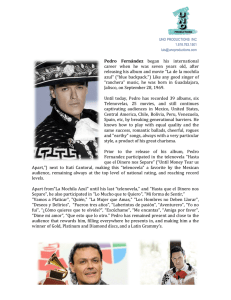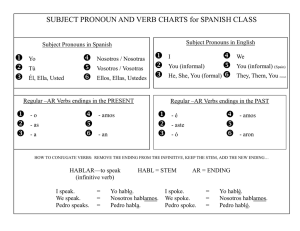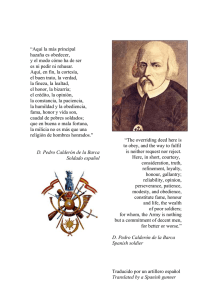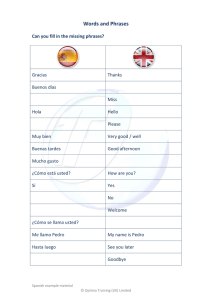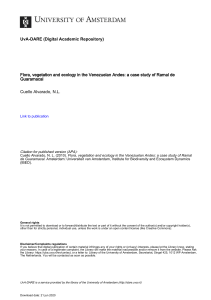WATER-IMAGERY AND THE THEME OF DISILLUSION IN PEDRO
Anuncio
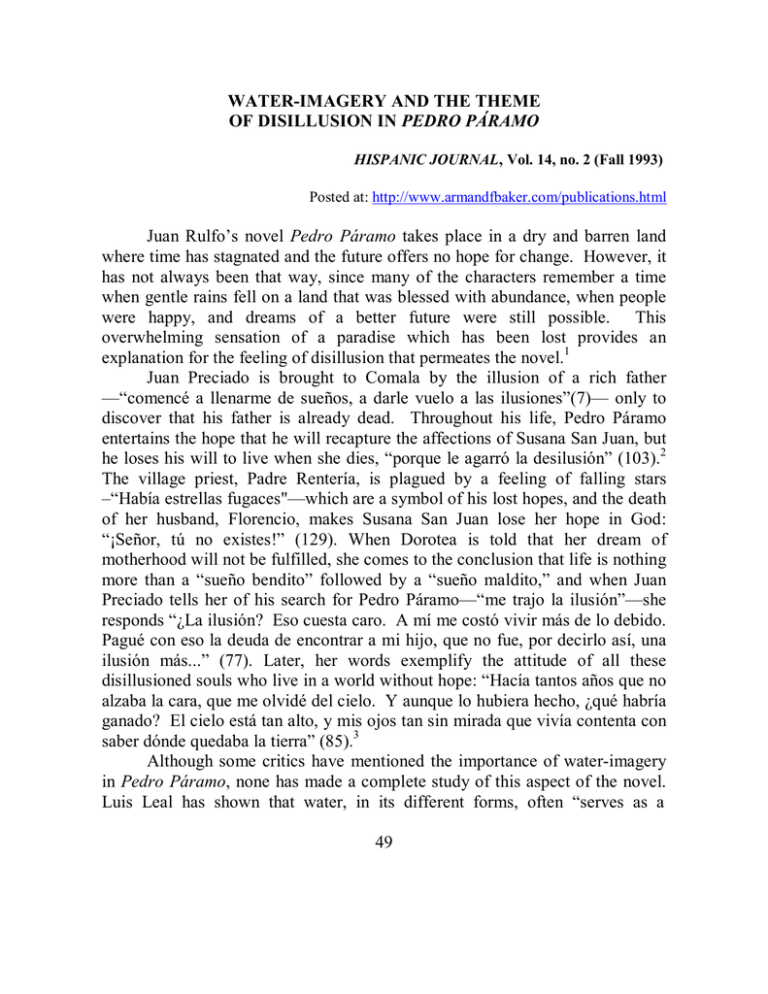
WATER-IMAGERY AND THE THEME OF DISILLUSION IN PEDRO PÁRAMO HISPANIC JOURNAL, Vol. 14, no. 2 (Fall 1993) Posted at: http://www.armandfbaker.com/publications.html Juan Rulfo’s novel Pedro Páramo takes place in a dry and barren land where time has stagnated and the future offers no hope for change. However, it has not always been that way, since many of the characters remember a time when gentle rains fell on a land that was blessed with abundance, when people were happy, and dreams of a better future were still possible. This overwhelming sensation of a paradise which has been lost provides an explanation for the feeling of disillusion that permeates the novel.1 Juan Preciado is brought to Comala by the illusion of a rich father —“comencé a llenarme de sueños, a darle vuelo a las ilusiones”(7)— only to discover that his father is already dead. Throughout his life, Pedro Páramo entertains the hope that he will recapture the affections of Susana San Juan, but he loses his will to live when she dies, “porque le agarró la desilusión” (103).2 The village priest, Padre Rentería, is plagued by a feeling of falling stars –“Había estrellas fugaces"—which are a symbol of his lost hopes, and the death of her husband, Florencio, makes Susana San Juan lose her hope in God: “¡Señor, tú no existes!” (129). When Dorotea is told that her dream of motherhood will not be fulfilled, she comes to the conclusion that life is nothing more than a “sueño bendito” followed by a “sueño maldito,” and when Juan Preciado tells her of his search for Pedro Páramo—“me trajo la ilusión”—she responds “¿La ilusión? Eso cuesta caro. A mí me costó vivir más de lo debido. Pagué con eso la deuda de encontrar a mi hijo, que no fue, por decirlo así, una ilusión más...” (77). Later, her words exemplify the attitude of all these disillusioned souls who live in a world without hope: “Hacía tantos años que no alzaba la cara, que me olvidé del cielo. Y aunque lo hubiera hecho, ¿qué habría ganado? El cielo está tan alto, y mis ojos tan sin mirada que vivía contenta con saber dónde quedaba la tierra” (85).3 Although some critics have mentioned the importance of water-imagery in Pedro Páramo, none has made a complete study of this aspect of the novel. Luis Leal has shown that water, in its different forms, often “serves as a 49 50 HISPANIC JOURNAL transition device to bring the reader into the world of Pedro Páramo” (85). Ciaran Cosgrove points to “water’s generally positive associations in the novel” (84), and Enrique Pupo-Walker says that images like water, voices, wind and shadows are used as “fuertes símbolos de vitalismo cósmico” (171). It has been shown that the image of water changes in different parts of the novel. Hugo Rodríguez Alcalá finds that Rulfo uses rain “para simbolizar la frescura de la vida” (191). María Luisa Bastos notes that “las lluvias bienhechoras” of the time of fertility are soon replaced by “los diluvios cataclísmicos que son telón de fondo de la agonía de Susana San Juan” (409). Several writers have pointed to the contrast between the image of water and that of stone, which is suggested by the name “Pedro Páramo.” As PupoWalker puts it: “Contrasta el símbolo lírico y fluido del agua—tan presente en la mente de Pedro Páramo—con el hermetismo duro de la tierra seca y la piedra que también llevan dentro Pedro Páramo y otros personajes” (166-167). In his study of comparisons in Rulfo’s work, Octavio Armand states that the contrast between water and stone is what separates Susana San Juan from Pedro Páramo: “Susana San Juan, la de los ojos de agua marina, siempre fascinada por el mar, corresponde a lo líquido. . . Pedro Páramo, casi Piedra Piedras, es lo árido, lo mineral, si se quiere. . .” (342-343). Ciaran Cosgrove has observed that Susana is associated with air and water in contrast to the “earth-bound” condition of Pedro Páramo (84). Martha Canfield has also affirmed that the action of Pedro Páramo follows a trajectory which starts with water and ends with stone: “La alternancia de los dos tiempos, con principio en el movimiento horizontal implícito en Vine a Comala y con final en el movimiento vertical implícito en la caída a tierra de Pedro Páramo muerto, sugiere que el tiempo del padre, desde que empieza nombrando el agua en la unidad 6, asalta el tiempo del hijo. . . y finalmente lo detiene en la muralla de piedra de su propia caída” (981). It could be stated, therefore, that all life in Pedro Páramo moves from water to stone (the lack of water) in the same way that the characters change from an attitude of hope, to one of desperation. With this in mind, I will examine the changes in the water-imagery as they constitute a symbolic parallel to the progression that leads from illusion to disillusion. Before I do that, however, it is necessary to make a brief reference to the structure of the novel. PEDRO PÁRAMO 51 The structure of Pedro Páramo is organized around two different narrative voices.4 The novel begins with the first person narrative of Juan Preciado which continues until page 17, when it is interrupted for the first time by another narrator speaking in third person. This narrator describes certain events relating to the life of Pedro Páramo that take place in an earlier period of time. This means that the novel is composed of a series of fragments that alternate between these two narrative voices. Most of the water images which I will examine are found in the third person narrative that describes the life of Pedro Páramo. In chronological terms, the first fragment of the third person narrator on page 17 is the beginning of the action. Here we encounter a youthful Pedro Páramo as he remembers the happy moments of his relationship with Susana San Juan. However, even before the protagonist is introduced, we are given a description of water that foreshadows the events which will occur: El agua que goteaba de las tejas hacia un agujero en la arena del patio. . . Ya se había ido la tormenta. Ahora de vez en cuando la brisa sacudía la ramas del granado haciéndolas chorrear una lluvia espesa, estampando la tierra con gotas brillantes que luego se empañaban. . . (17) The falling water penetrates the soft sand, suggesting the presence of some sort of destructive power, but even more significant is the final phrase of this opening description: “. . . gotas brillantes que luego se empañaban.” In the image of these shining drops of water which lose their brilliance, we have a precise indication of the path that the characters will follow, as they move from an attitude of illusion to one of disillusion. Following the pattern that is suggested by this opening description, water-images are first linked to a sense of beauty and happiness, as the narrator describes the raindrops which are full of glowing colors and sparkling light: Al recorrerse las nubes, el sol sacaba luz a las piedras, irisaba todo de colores, se bebía el agua de la tierra, jugaba con el aire dándole brillo a las hojas con que jugaba el aire. (18) Immediately, we see that this description mirrors the emotions of Pedro Páramo and that in his thoughts the water-motif is associated with Susana San Juan: 52 HISPANIC JOURNAL Pensaba en ti, Susana . . . Tus labios estaban mojados como si los hubiera besado el rocío . . . De ti me acordaba. Cuando tú estabas allí mirándome con sus ojos de aguamarina . . . (18-19) A similar view of water, as it is seen during this early period of time, is found in the words of Juan Preciado’s mother, when she describes the beneficial effects of the rain: Mi madre me decía que, en cuanto comenzaba a llover, todo se llenaba de luces y del olor de los retoños. Me contaba cómo llegaba la marea de las nubes, cómo se echaban sobre la tierraa y la descomponían cambiándose los colores . . . (84) Contrary to what we will see in the latter part of the novel, the rain at this time is a positive force which is associated with a state of abundance, as well as a feeling of joy and satisfaction. A further indication of this fact is implicit in the words of Susana San Juan when she associates the possibility of rain with “el tiempo bueno” of her youth. As she describes it: “El viento bajaba de las montañas en las mañanas de febrero. Y las nubes se quedaban allá en espera de que el tiempo bueno las hiciera bajar al valle. . .” (98). When the third person narrative continues, it is not long before a change occurs in the associations that are connected with the image of water. At this point Pedro Páramo is thinking of the day that Susana departed—“El día que te fuiste entendí que no te volvería a ver” (28)—, and it now becomes evident that the positive phase of the water-imagery has come to an end: Por la noche volvió a llover. Se estuvo oyendo el borbotar del agua durante largo rato. . . Los vidrios de la ventana estaban opacos, y del otro lado las gotas resbalaban en hilos gruesos como de lágrimas. “Miraba caer las gotas iluminadas por los relampagos, y cada [vez] que respiraba suspiraba, y cada vez que pensaba, pensaba en ti, Susana...” (21) Where earlier images full of color and light reflected the happiness Pedro experienced in the company of his beloved, these opaque drops of water are associated with the tears produced by the overwhelming sense of her loss. True to the pattern established y the opening description, we will see that throughout the rest of the novel water has a negative connotation. Shortly after this, the water-motif is used to introduce the death of don Lucas, Pedro’s father. On page 32, a fragment of the third person narrative PEDRO PÁRAMO 53 begins with a description of falling water, and the drops that overflow onto the floor foreshadow the spilling of blood which is to follow: En el hidrante las gotas caen una tras otra. Uno oye, salida de la piedra, el agua clara caer sobre el cántaro . . . Las gotas siguen cayendo sin cesar. El cántaro se desborda haciendo rodar el agua sobre un suelo mojado . . . Se oyen las gotas de agua que caen del hidrante sobre el cántaro raso. Se oyen pasos que se arrastran . . . Y el llanto. (32-33). The death of don Lucas is a crucial point in the novel because it is at this time that Pedro takes over his family’s affairs, including the execution of those who attended the wedding where his father was killed.5 As an indication that this is the moment in which his evil power is unleashed, we have a series of bad omens which culminate in the description of darkness which returns at dawn: Por la puerta se veía el amanecer en el cielo. No había estrellas. Sólo un cielo plomizo, gris, aún no aclarado por la luminosidad del sol. Una luz parda, como si no fuera a comenzar el día, sino como si apenas estuviera llegando el principio de la noche. (33) Then, as though she represents the figure of death, it is his mother standing in the doorway whose body prevents the arrival of daylight. Her foreboding image is surrounded by showers of watery light like tears—“y debajo de sus pies regueros de luz; una luz asperjada como si el suelo debajo de ella estuviera anegado en lágrimas” (33-34)—and Pedro Páramo asks enigmatically: “¿Y a ti quién te mató, madre?” (34). At this point, the third person narrative is interrupted by the narrative of Juan Preciado, who describes the events leading up to his death. For a while, the water-motif ceases to appear; however, as he speaks with Dorotea in their common grave, Juan Preciado mentions that it is raining. This serves as a stimulus which produces a return to the third person narrative where Fulgor Sedano is watching the rain on a cloudy morning. Since this passage is important, I will quote at some length: Al amanecer, gruesas gotas de lluvia cayeron sobre la tierra. Sonaban huecas al estamparse en el polvo blando y suelto de los surcos. Un pájaro burlón cruzó a ras del suelo y gimió imitando el quejido de un niño; más allá se le oyó dar un gemido como de cansancio, y todavía más lejos, por donde comenzaba a abrirse el horizonte, soltó un hipo y luego una risotada, para volver a gemir después. 54 HISPANIC JOURNAL Fulgor Sedano sintió el olor de la tierra y se asomó a ver cómo la lluvia desfloraba los surcos. Sus ojos pequeños se alegraron. . . “¡Vaya!—dijo—. Otro buen año se nos echa encima.” Y añadió: “Ven, agüita, ven. ¡Déjate caer hasta que canses! Después córrete para allá, acuérdate que hemos abierto a la labor toda la tierra, nomás para que te des gusto.” Y soltó la risa. El pájaro burlón que regresaba de recorrer los campos pasó casi frente a él y gimió con un gemido desgarrado. El agua apretó su lluvia hasta que allá, por donde comenzaba a amanecer, se cerró el cielo y pareció que la oscuridad, que ya se iba, regresaba. La puerta grande de la Media Luna rechinó al abrirse, remojada por la brisa. Fueron saliendo primero dos, luego otros dos después otros dos y así hasta doscientos hombres a caballo que se desparramaron por los campos lluviosos. . . Les iba ordenando Fulgor Sedano . . . “¡Y apriétenle, que se nos vienen encima las aguas!” (79-81). Immediately after this Miguel Páramo appears and, while others joke about his sexual prowess, he makes an agreement with Dorotea—“Ven para acá, te voy a proponer un trato” (82)—according to which she will help him find women to seduce. Fulgor Sedano then tells Pedro Páramo that Miguel has killed another man, but Pedro objects on the grounds that his son is too young: “él es incapaz de hacer eso: no tiene todavía fuerza para matar a nadie. . . Es apenas un niño” (83). As the fragment ends, Fulgor Sedano once again contemplates the cloudy sky and his final words are a prediction: “Tendremos agua para un buen rato” (84). At this point in the novel it is clear that the rain has become a symbol of the destructive influence of Pedro Páramo which falls on the land and its people. Then, the rain is also a phallic symbol representing the sexual activity of Miguel Páramo which is discussed in this fragment. This can be seen in the words: “[las gotas] sonaban huecas al estamparse en el polvo blando y suelto de los surcos,” (79), and it is especially evident in the expression: “la lluvia desfloraba los surcos” (80).6 This is not a contradiction of the idea that the rain symbolizes the influence of Pedro Páramo, since it is clear that Miguel’s power is only an extension of that of his father. Pedro admits as much when he remarks to Fulgor Sedano: “La culpa de todo lo que él haga échamela a mí” (83). The “pájaro burlón” which imitates the crying of a child can also be seen as an ironic symbol of the son—“es apenas un niño”—who is nothing more than an ironic reflection of the father. PEDRO PÁRAMO 55 When Fulgor Sedano speaks to the water using the diminutive form—“Ven, agüita, ven”—this is another indication that at this moment the rain symbolizes the lesser evil represented by Miguel Páramo. The rest of Fulgor’s words —“¡Déjate caer hasta que te canses! Después córrete para allá, acuérdate que hemos abierto a la labor toda la tierra, nomás para que te des gusto”—have an ironic double meaning. On the one hand, he speaks as a farmer who is grateful for the rain which falls on the newly plowed ground; however, when he speaks to the rain it is also as though he is encouraging the actions of Miguel Páramo and, by extension, those of his father. His reference to the newly plowed ground is a gruesome reminder of those who have been killed, and then buried, so that this evil power may continue to prosper. The reappearance of the “pájaro burlón” who, like Miguel Páramo, returns from a trip through the countryside, reinforces the symbolism of Fulgor’s words. Then, when the rainfall becomes so dense that the light is blotted out, for the second time in the novel we have the image of darkness that overshadows the dawn. On the previous occasion, it symbolized the unleashing of Pedro Páramo’s destructive power after the death of his father; here it represents the beginning of the harmful activities of his son, Miguel. The ominous description of the men who go forth from Pedro Páramo’s gate into the rain-soaked countryside is an indication of the growth of his negative influence. Fulgor Sedano’s prophecy at the end of this fragment—“Tendremos agua para un buen rato”—turns out to be an accurate one. When the water-image reappears on page 110, the Indians’ fearful reaction makes it clear that the rain still represents the destructive power of Pedro Páramo which is felt by those who live in the region of Comala: Sobre los campos del valle de Comala está cayendo la lluvia. Una lluvia menuda, extraña para estas tierras que sólo saben de aguaceros . . . la lluvia sigue cayendo sobre los charcos. . . Los indios esperan. Sienten que es un mal día. Quizá por eso tiemblan debajo sus mojados “gabanes” de paja; no de frío sino de temor. Y miran la lluvia desmenuzada y al cielo que no suelta sus nubes . . . . (110) Pedro Páramo’s power has now become firmly established and the rain which is a symbol of his power has a diminishing effect on all activity, as though the rain is the very substance from which life is made: “La lluvia amortigua los ruidos. Se sigue oyendo aún después de todo, granizando sus gotas, hilvanando el hilo de la vida” (112).7 56 HISPANIC JOURNAL By now Pedro has been able to re-establish contact with Susana San Juan, and so that his control of her life will be complete, he has instructed Fulgor Sedano to kill her father, Bartolomé San Juan (109). As Susana struggles with the madness which has resulted from the loss of her first husband, the constant sound of rain forms a counterpoint to her thoughts: “Alla fuera se oía el caer de la lluvia sobre las hojas de los plátanos, se sentía como si el agua hirviera sobre el agua estancada en la tierra” (114). Someone comes to announce that her father has died, and like Pedro Páramo’s all-compassing influence, the rain continues to fall as though it will never end: “Y después sólo la lluvia, itermitente, fría, rodando sobre las hojas de los plátanos, hirviendo en su propio hervor” (115). “Afuera seguía lloviendo. Los indios se habían ido. Era lunes y el valle de Comala seguía anegándose en lluvia” (117). Finally, a day comes when the rain stops. However, the threat which the rain represents has not ended, since it has now been replaced by the wind. Furthermore, this is the wind that brought the rain, and it therefore contains the same destructive potential as before: Los vientos siguieron soplando todos los días. Esos vientos que habían traído las lluvias. La lluvia se había ido; pero el viento se quedó. Allá en los campos la milpa oreó sus hojas y se acostó sobre los surcos para defenderse del viento. De día era pasadero; retorcía las yedras y hacía crujir las tejas en los tejados; pero de noche gemía largamente. (117) Shortly afterward, we learn what is behind this change from the rain to the wind. Pedro’s agent, Fulgor Sedano, has been killed by the revolutionaries and, even more important, his will to act has been paralyzed by the failure of his efforts to capture the love of Susana San Juan: “Pedro Páramo volvió a encerrarse en su despacho. Se sentía viejo y abrumado . . . “ (121) This is still not the end of Pedro Páramo's negative influence. Although he no longer takes an active part in the affairs of Comala, the destructive effect of his power continues on an even larger scale as it becomes part of the Mexican Revolution. Instead of trying to fight the rebel soldiers who killed Fulgor Sedano, Pedro offers to help by sending an equal number of his own men to join them. He tells el Tilcuate to round up three hundred men to accompany the revolutionaries, and by the time they join the army of Pancho Villa, this number has grown to seven hundred. When they ask him for money, Pedro tells them to rob the village of Contla, and we see that even though his PEDRO PÁRAMO 57 personal power has begun to decay, the violence that he initiated will go on without him: “Pedro Páramo miró cómo los hombres se iban. Sintió desfilar frente a él el trote de caballos oscuros, confundidos con la noche. . . Quedaba él, solo, como un tronco duro comenzando a desgajarse por dentro: (138-139). El Tilcuate returns to tell Pedro that they have joined forces with Caranza, and then with Obregón. When the fighting finally comes to an end, Pedro tells him to disband his army. However, el Tilcuate wants to join the revolution of the “Cristeros” and Pedro replies: “Haz lo que quieras, entonces. . . Haz lo que quieras . . . “ (150). With the loss of his power, it is evident that for Pedro Páramo all hope of change has vanished, and the early moments of happiness which were reflected in the water-motif are now nothing more than a bitter memory. Two incidents connected with water near the end of the novel clearly illustrate this tragic outcome. The first occurs when Pedro’s illegitimate son, Abundio Martínez, drinks a bottle of alcohol to drown the sorrow caused by the death of his wife. Moments later, he stabs Pedro Páramo in a drunken stupor, and as he is taken away, he begins to vomit: “Se hizo a un lado y allí vomitó una cosa amarilla como de bilis. Chorros y chorros, como si hubiera sorbido diez litros de agua” (157) We have seen that water has been used to represent the negative influence of Pedro Páramo, and in this act of revenge it is as though Abundio has purged himself of all the evil that he had inherited from his father. Then, shortly before he dies, Pedro recalls a now unobtainable moment of happiness which he experienced with Susana, and in his memory the waterimage is still associated with his lost beloved: “Suave, restregada de luna; tu boca abullona humedecida, irisada de estrellas; tu cuerpo transparentándose en el agua de la noche, Susana, Susana San Juan” (158). After Susana’s death Pedro spends the rest of his days seated in an old wicker chair near the gate of Media Luna, and the contrast between the ephemeral nature of his memory and his own progressive mineralzation only serves to emphasize the tragic conclusion of his life.8 Looking back in retrospect, it can be said that at the beginning of the novel water represents the abundance of life which is associated with love and happiness while Pedro Páramo is a child. However, after the death of his father and the loss of Susana, Pedro is converted into “un rencor vivo.” Once his life is contaminated with hate and selfishness, he becomes a negative force that destroys everything it touches, including himself. For this reason Pedro finally loses his will to act, and in the end he is killed by his own son. Without will, 58 HISPANIC JOURNAL and without the unifying power of love, Pedro Páramo has become, as his name suggests, nothing more than a sterile pile of stones: “Dio un golpe seco contra la tierra y se fue desmoronando como si fuera un montón de piedras” (159). The Mexican novelist, Carlos Fuentes, has seen a close relationship between the events which are described in Pedro Páramo, and the history of Mexico: Novela misteriosa, mística, musitante, murmurante, mugiente y muda. Pedro Páramo concentra así todas las sonoridades muertas del mito. Mito y muerte; ésas con las dos “emes” que coronan todas las demás antes de que las corone el nombre mismo de México. . . (14). By choosing the name “Pedro Páramo,” and by ending the novel as the protagonist disintegrates into a pile of stones, Rulfo has suggested that what his character represents—Pedro/piedra—has become an integral part of Mexico –Páramo/desierto. Thus, Rulfo joins those authors who, from Mariano Azuela to Fuentes himself, have described what they feel is the failure of the social order which followed the Mexican Revolution. As we find it reflected in the characters of his novel, Rulfo’s view of life is not a totally nihilistic one; memories of former times show that good things have existed in the past. However, this goodness has now been destroyed by the actions of those in power, who are represented by Pedro Páramo. This means that Rulfo’s novel can be seen as a protest directed against the power-structure which exploits the Mexican people. His work offers no hope, but the sense of disillusion which it portrays tells us that, if the future is bleak, it should not be that way. State University of New York at Albany Posted at: http://www.armandfbaker.com/publications.html Armand F. Baker PEDRO PÁRAMO 59 NOTES 1 The theme of “Paradise Lost” which has received a great deal of attention from those who have studied Pedro Páramo is of course very similar to that of disillusion. In his book about Rulfo, Luis Ortega Galindo has discussed both of these themes: “Como México, el hombre de Rulfo sueña con un paraíso que está ubicado en el pasado; así Dolores, Juan, Pedro Dorotea, Eduviges, Susana y Rentería. . . viven en la ilusión de un espacio o un tiempo ya desaparecidos o ausentes. Los héroes de Rulfo nos dan su visión de la vida, siempre en busca de la ilusión inalcanzable, incluso para el casi todopoderoso cacique, al que Susana San Juan se le escapa siempre” (373). 2 Yvette Jiménez de Báez has also observed that Rulfo’s novel contains themes of illusion and disillusion: “La vida del hombre en Pedro Páramo se orienta por el camino de la ilusión imaginativa (lo positivo, lo alto) como le ocurre a Juan Preciado. . . o de la desilusión como a Pedro Páramo en la caída de su mundo” (n938). 3 In his study of “La caída de la gracia,” George Ronald Freeman has written that for the Characters of Pedro Páramo “El proceso de la vida es una erosión, donde se cae de la esperanza y de las ilusiones a una desesperanza fatal” (74). 4 For a more complete study of the structure of Pedro Páramo, see “La estructura de Pedro Páramo” by Luis Leal (La narrativa, 44-54). 5 Dorotea refers to the way in which Pedro Páramo reacted to his father’s death when she is speaking to Juan Preciado in the grave: “Pedro Páramo causó tal mortandad después que le mataron a su padre, que se dice que casi acabó con los asistentes a la boda en la cual don Lucas Páramo iba a fungir de padrino. Y eso que a don Lucas nomás le tocó de rebote, porque al parecer la cosa era contra el novio. Y como nunca se supo de dónde había salido la bala que le pegó a él, Pedro Páramo arrasó parejo” (102). 6 Ciaran Cosgrove has commented on the sexual connotation of the “gruesas gotas” and the “surco” in this passage: “The activity described is clearly penetrative. The image of penetration is enhanced by a somewhat over determined subject ‘gruesas gotas’ that, somewhat hyperbolically, makes an imprint (‘estamparse’) in the dusty earth of the furrow. This earth is ‘blando,’ an adjective used later to qualify ‘carne’ in the most sexually explicit passage in the novel. . . in which ‘surco’ is used in an overtly sexual way. Also, the use here of the verb ‘desfloraba’ cannot easily be disengaged from its now current metaphorical meaning” (83). 7 Luis Ortega Galindo has commented on the rain in this passage as a “símbolo de la vida que se va deshaciendo en gotas” (87), but he does not mention the rain as a symbol of the influence of Pedro Páramo. 8 Pedro Páramo’s tragic separation from the beneficial effect of water represented by Susana San Juan has been described by Ciaran Cosgrove: “As Susana becomes progressively etherealized, so is she imagined in terms of the waters of the atmosphere. Pedro Páramo’s homage to Susana is as [futile] as his own earth-bound condition. . . is illustrative of the gulf that separates them” (85). 60 HISPANIC JOURNAL WORKS CITED Armand, Octavio. “Sobre las comparaciones de Rulfo,” Homenaje a Juan Rulfo, E. Helmy Giacoman, Long Island City: ANAYA-Las Americas, 1974: 335-346. Bastos, María Luisa. “Tópicos y núcleos narrativos en Pedro Páramo,” Cuadernos hispanoamericanos, 421-423 (1985): 404-410. Canfield, Martha L. “Dos enfoques de Pedro Páramo,” Revista iberoamericana, 148-149 (1989): 965-988. Cosgrove, Ciaran. “Abstract Gestures and Elemental Pressures in Juan Rulfo’s Pedro Páramo,” Modern Language Review, 86, 1 (January 1991): 79-88. Freeman, George Ronald. “La caída de la gracia: clave arquetípica de Pedro Páramo,” La narrativa de Juan Rulfo: Interpretaciones críticas, Ed. Joseph Sommers. Mexico: Sep/Setentas, 1974: 67-75. Fuentes, Carlos. “Mugido, Muerte y Misterio: El mito de Rulfo,” Revista iberoamericana, 116-117 (1981), 11-21. Jiménez de Báez, Yvette. “Juan Rulfo: De la estructura al sentido,” Revista iberoamericana, 148-149 (1989): 937-952. Leal, Luis. “La estructura de Pedro Páramo,” La narrativa de Juan Rulfo: Interpretaciones críticas, Ed. Joseph Sommers. Mexico: Sep/Setentas, 1974: 44-54. ________. Pedro Páramo. Boston: Twayne Publishers, 1983. Ortega Galindo, Luis. Expresión y Sentido de Juan Rulfo. Madrid: José Porrúa Turanzas, 1984. Pupo-Walker, Enrique. “Tonalidad, estructuras y rasgos del language en Pedro Páramo,” Homenaje a Juan Rulfo, E. Helmy Giacoman. Long Island City: ANAYALas Americas, 1974: 159-171. Rodríguez-Alcalá, Hugo. El arte de Juan Rulfo. Mexico: Instituto Nacional de Bellas Artes, 1965; Rulfo, Juan. Pedro Páramo. Mexico: Fondo de Cultura Económica, 1987.

